The Smart Fitness Mirror Market is estimated to be valued at USD 360.0 billion in 2025 and is projected to reach USD 663.3 billion by 2035, registering a compound annual growth rate (CAGR) of 6.3% over the forecast period.
In the early years from 2025 to 2030, market growth will be driven by rising adoption across urban households, fitness enthusiasts, and premium gym chains integrating smart mirrors for virtual training and performance tracking. By 2030, the market is expected to surpass USD 485.0 billion, demonstrating strong adoption momentum.
Between 2030 and 2035, growth continues as advanced AI features, biometric monitoring, and content subscription models enhance the value proposition, raising the market size to USD 663.3 billion. The incremental expansion of USD 303.3 billion highlights the market’s potential to transition from a luxury segment into a mainstream fitness tool. Competition will intensify as consumer electronics firms, fitness equipment manufacturers, and digital training platforms converge to offer differentiated experiences. With North America, Europe, and Asia-Pacific driving demand, smart fitness mirrors are positioned to redefine connected fitness ecosystems and become integral to health-focused lifestyles worldwide.

| Metric | Value |
|---|---|
| Smart Fitness Mirror Market Estimated Value in (2025 E) | USD 360.0 billion |
| Smart Fitness Mirror Market Forecast Value in (2035 F) | USD 663.3 billion |
| Forecast CAGR (2025 to 2035) | 6.3% |
The smart fitness mirror market is expanding steadily, fueled by increasing demand for home based fitness solutions, personalized workout experiences, and integration of advanced technology in daily routines. The growing popularity of virtual training programs, real time performance tracking, and interactive feedback features is driving adoption across urban and tech savvy demographics.
Consumers are seeking seamless fitness ecosystems that offer convenience, interactivity, and space efficiency, making smart mirrors an attractive choice. Technological advancements such as AI driven coaching, biometric feedback, and cloud based workout libraries have significantly enhanced the utility of fitness mirrors.
The market is also benefiting from the convergence of wellness, interior design, and connected home trends. As health awareness continues to rise and digital platforms dominate the fitness landscape, smart fitness mirrors are expected to become an integral part of the connected wellness ecosystem.
The smart fitness mirror market is segmented by type, frame material, price range, shape, screen size, end use, distribution channel, and geographic regions. By type, the smart fitness mirror market is divided into wall-mounted and floor-standing. In terms of frame material, the smart fitness mirror market is classified into Glass, Silver mirror, Metal, Steel, Aluminum, Copper, and Stainless steel. Based on price range of the smart fitness mirror market is segmented into Low, Medium, and High.
By shape, the smart fitness mirror market is segmented into Rectangle, Round, and Oval. By screen size, the smart fitness mirror market is segmented into up to 32", 32"-43", and More than 43". By end use, the smart fitness mirror market is segmented into Individual and Commercial. By distribution channel, the smart fitness mirror market is segmented into Online and Offline. Regionally, the smart fitness mirror industry is classified into North America, Latin America, Western Europe, Eastern Europe, Balkan & Baltic Countries, Russia & Belarus, Central Asia, East Asia, South Asia & Pacific, and the Middle East & Africa.
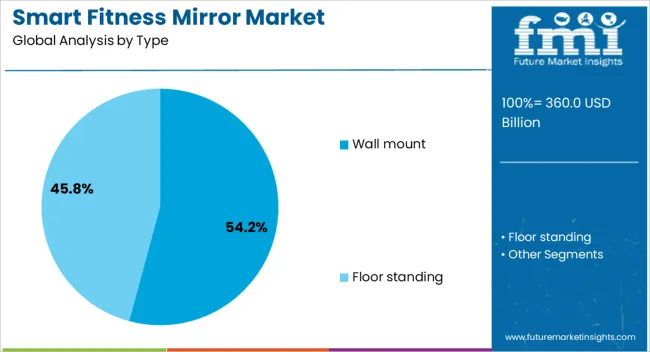
The wall mount segment is expected to contribute 54.20% of total market revenue by 2025 within the type category, making it the leading segment. This dominance is supported by its space-saving design, ease of installation, and compatibility with a variety of home interiors.
Consumers prefer wall-mounted mirrors due to their stability, aesthetic appeal, and compact footprint, particularly in small living spaces. Additionally, the segment benefits from being aligned with premium offerings that integrate advanced features such as touchscreen interfaces and AI workout assistants.
As more users adopt home fitness regimens, the demand for sleek and multifunctional equipment is elevating the adoption of wall mounted smart mirrors as the preferred format.
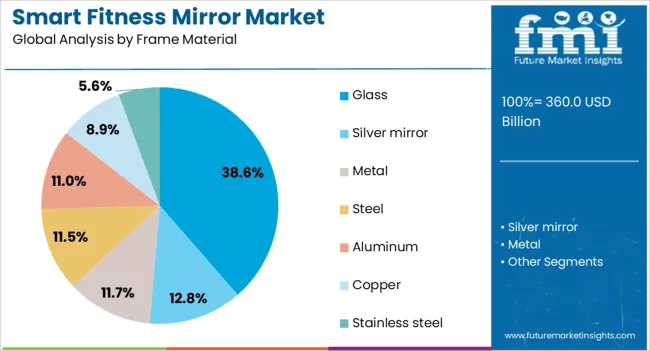
The glass segment under frame material is projected to hold 38.60% of total market revenue by 2025, reflecting its popularity for its premium appearance and seamless integration with smart display technologies. Glass enables clearer visuals, touch responsiveness, and higher durability, making it the material of choice for interactive fitness mirrors.
It also enhances the aesthetic value of the product, appealing to consumers who seek a blend of performance and design. The use of tempered or shatter-resistant glass further boosts safety and reliability, especially in high-intensity training environments.
With growing preference for products that combine technology and visual elegance, glass-based frames continue to dominate the material segment.
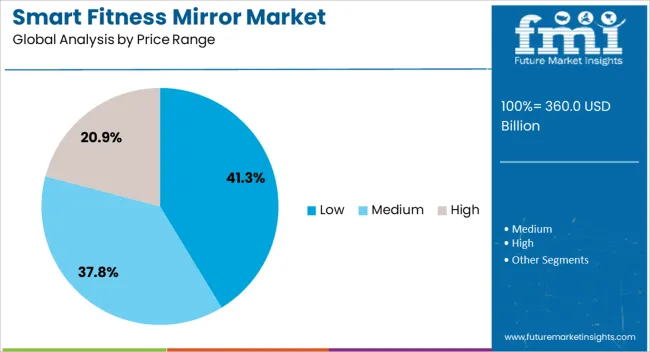
The low price range segment is anticipated to represent 41.30% of total market revenue by 2025, making it the most accessible and widely adopted pricing tier. This segment's growth is driven by the need for cost effective fitness solutions that offer core functionalities without premium pricing.
As smart fitness mirrors become more mainstream, entry-level models are gaining popularity among budget-conscious consumers and first-time buyers. Manufacturers are responding with simplified versions that retain essential features such as workout tracking and connectivity while minimizing hardware complexity.
The affordability of low-tier options is enabling broader market penetration, particularly in emerging markets and among young fitness enthusiasts, reinforcing its leading position in the pricing structure.
The smart fitness mirror market is expanding due to rising demand for home fitness, integration with digital ecosystems, and growth in subscription models. Increased investment in fitness tech continues to drive innovation and market expansion.
The increasing interest in home fitness solutions is a significant driver for the smart fitness mirror market. Consumers are shifting from traditional gym memberships to in-home workout equipment due to the convenience, privacy, and flexibility it offers. Smart fitness mirrors are an attractive option because they combine the functionality of a mirror with virtual fitness coaching. They allow users to access a wide range of exercises, including yoga, strength training, and cardio, all from the comfort of their home. The growing desire for personalized fitness experiences and the ability to monitor progress in real-time further fuel the demand for these mirrors, making them a desirable choice for fitness enthusiasts.
Smart fitness mirrors are increasingly integrated with other digital fitness ecosystems, such as mobile apps and wearable devices. This integration allows users to track their workouts, set goals, and monitor progress seamlessly. The ability to sync with fitness apps and other smart devices enhances the overall user experience by providing real-time data and personalized recommendations. These features have made smart fitness mirrors an essential tool for those looking for a more interactive and immersive fitness experience. By offering multi-device compatibility, these mirrors can cater to a wide audience, including users who already engage with other fitness technologies, creating a broader market appeal.
The rise of subscription-based content models is a key factor in the expansion of the smart fitness mirror market. Companies are increasingly offering paid subscriptions that provide access to exclusive workout classes, tutorials, and personalized fitness plans. These subscriptions not only generate ongoing revenue but also enhance user engagement by offering fresh, on-demand content that encourages regular use. The subscription model has proven successful in retaining customers by keeping them engaged with new content and features. This model ensures that users continuously benefit from the mirror’s capabilities, turning the device into a long-term investment rather than a one-time purchase.
Increased investment in fitness technology, including smart fitness mirrors, is driving market growth. Venture capital firms and private equity investors are increasingly recognizing the potential of the fitness technology market and pouring funds into companies developing smart fitness products. This influx of investment is enabling companies to expand their product offerings, improve mirror capabilities, and scale their operations globally. As more players enter the market, competition is intensifying, leading to the development of more advanced and affordable products. With the growing popularity of home fitness and the demand for innovative workout solutions, this increased investment is crucial for sustaining the market’s growth and addressing customer needs.
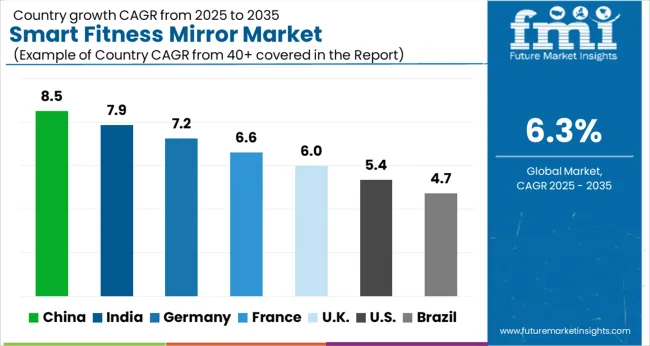
| Countries | CAGR |
|---|---|
| China | 8.5% |
| India | 7.9% |
| Germany | 7.2% |
| France | 6.6% |
| UK | 6.0% |
| USA | 5.4% |
| Brazil | 4.7% |
The smart fitness mirror market is projected to grow globally at a CAGR of 6.3% from 2025 to 2035, with significant contributions from key countries. China leads with a growth rate of 8.5%, driven by the increasing demand for home fitness solutions and the rapid expansion of digital fitness platforms. India follows closely at 7.9%, with the rising adoption of connected fitness devices and increasing health consciousness among consumers. France grows at 6.6%, driven by a high adoption of smart home technologies and a rising interest in fitness at home. The UK achieves 6.0%, with the expanding popularity of fitness technology and personalized training experiences. The USA shows a growth rate of 5.4%, driven by steady demand for interactive fitness solutions and increasing investments in fitness technologies. This analysis highlights the global expansion of the smart fitness mirror market, with strong growth in China and India, steady growth in Europe, and stable demand in the USA
The UK is projected to post a CAGR of 6.0% for 2025–2035, up from an estimated 5.2% during 2020–2024, surpassing the global average of 6.3%. This increase is driven by the growing demand for at-home fitness solutions, especially in the wake of the pandemic. Consumers are shifting towards interactive fitness technology, and smart fitness mirrors provide an engaging and immersive workout experience. With the rise in health-consciousness and personalized fitness needs, the adoption of smart fitness mirrors continues to grow, supported by increased government initiatives promoting health and wellness. The expanding popularity of connected fitness ecosystems strengthens the demand for these products.
China is projected to achieve a CAGR of 8.5% for 2025–2035, up from 7.1% during 2020–2024, surpassing the global 6.3% average. This significant rise is fueled by the rapid urbanization of the middle-class consumer base and a shift toward wellness-focused living. As disposable incomes rise, more consumers are investing in smart home fitness technologies, with a focus on connected devices like smart fitness mirrors. The growing trend of online fitness content and mobile app usage also supports the adoption of these devices. China’s expanding digital infrastructure and increasing smartphone penetration further contribute to the market’s growth, as more consumers look for innovative and accessible workout solutions.
India is forecasted to achieve a CAGR of 7.9% for 2025–2035, surpassing the global average of 6.3%. The rise is supported by the growing wellness industry, increasing disposable income, and the expanding demand for connected fitness solutions. The shift to home-based fitness is accelerating in India, driven by convenience and affordability, with more consumers seeking smart fitness mirrors to integrate into their at-home workout routines. As internet penetration and smartphone usage continue to grow, the accessibility and popularity of smart fitness products are expected to increase. The rise in online fitness content and mobile apps facilitates the integration of smart mirrors into daily fitness routines, supporting their adoption in both urban and rural areas.
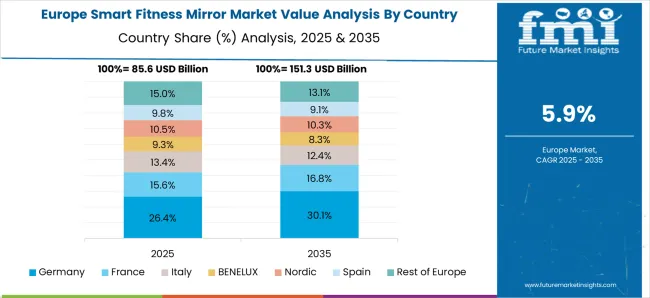
France is projected to grow at a CAGR of 6.6% for 2025–2035, surpassing the global 6.3%. The growth is driven by an increasing preference for digital health and fitness solutions, especially as consumers seek more personalized workout experiences. Smart fitness mirrors are gaining popularity in France due to their ability to provide a combination of convenience, interaction, and fitness tracking. With the rise in health consciousness and increasing interest in fitness technology, more consumers are investing in smart fitness mirrors as part of their at-home wellness solutions. France’s growing fitness influencer culture and the demand for on-demand workout content further bolster the market’s expansion.
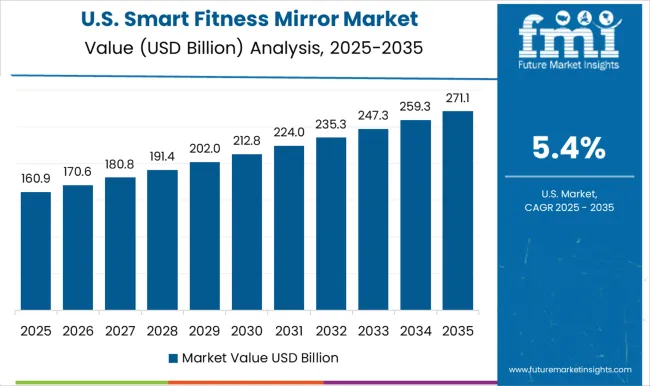
The USA smart fitness mirror market is expected to grow at a CAGR of 5.4% for 2025–2035, driven by a steady increase in the adoption of home fitness technologies. The market experienced a growth rate of 5.8% during 2020–2024, fueled by the rising popularity of at-home fitness solutions, especially post-pandemic. Consumers are increasingly looking for interactive fitness products, and smart fitness mirrors offer a combination of technology, convenience, and personalization. The USA continues to be one of the largest markets for fitness-related technology, and the demand for smart fitness mirrors is expected to rise as consumers prioritize health and wellness.
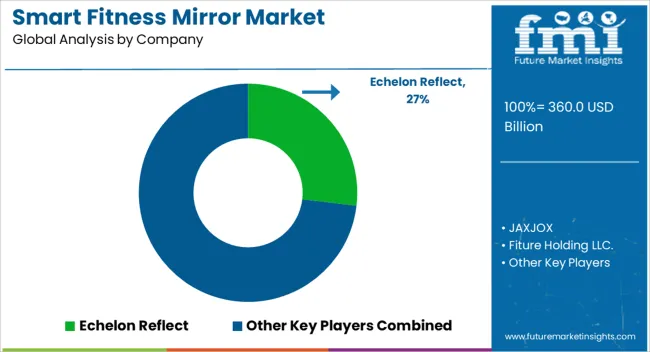
The smart fitness mirror market is competitive, with several prominent players offering innovative products and solutions that cater to various fitness needs. Echelon Reflect, a key player, offers a smart fitness mirror that integrates live streaming and on-demand classes, making it an attractive option for fitness enthusiasts seeking personalized workout experiences at home. JAXJOX is another significant player, focusing on offering fitness mirrors with advanced performance tracking, real-time feedback, and versatile workout options, positioning itself in the premium segment.
Fiture Holding LLC provides unique offerings with its motion-sensing smart mirror, which incorporates a wide range of exercises, including yoga, strength training, and boxing, offering an interactive fitness experience. FORME Life, part of the growing trend in connected fitness technology, delivers a high-end smart mirror that integrates AI for personalized fitness routines.
Lululemon, known for its activewear, has expanded into the smart fitness mirror market with its Mirror, offering a diverse workout library and an emphasis on mindfulness and holistic wellness. Magic Tech Ltd. focuses on providing fitness mirrors with advanced tracking capabilities, including form correction and progress analytics, designed for users aiming to perfect their workout techniques.
STANHOM and NordicTrack (iFit) have also made significant strides in the market by offering mirrors with access to personalized training programs, enabling users to select from a variety of fitness classes and on-demand workouts. Portl, ProForm Vue, and Tempo provide various smart fitness mirror solutions that combine AI, performance tracking, and tailored coaching, competing for the attention of both fitness professionals and home fitness users. OxeFit, Tonal, Vaha Technologies Limited, and Vercon Smart Mirror are also prominent contenders, each offering a unique combination of smart technologies, premium workout content, and immersive fitness experiences.
These players leverage fitness data, connectivity, and customizable workout plans to meet the growing demand for at-home fitness solutions. The competitive landscape is driven by innovation in smart fitness technology, with companies focusing on differentiating their offerings through AI integration, fitness tracking features, and exclusive content. Partnerships between fitness mirror manufacturers and fitness content creators are a key strategy for expanding their customer base and strengthening market position.
| Item | Value |
|---|---|
| Quantitative Units | USD 360.0 Billion |
| Type | Wall mount and Floor standing |
| Frame Material | Glass, Silver mirror, Metal, Steel, Aluminum, Copper, and Stainless steel |
| Price Range | Low, Medium, and High |
| Shape | Rectangle, Round, and Oval |
| Screen Size | Upto 32", 32"-43", and More than 43" |
| End Use | Individual and Commercial |
| Distribution channel | Online and Offline |
| Regions Covered | North America, Europe, Asia-Pacific, Latin America, Middle East & Africa |
| Country Covered | United States, Canada, Germany, France, United Kingdom, China, Japan, India, Brazil, South Africa |
| Key Companies Profiled | Echelon Reflect, JAXJOX, Fiture Holding LLC., FORME Life, Lululemon, Magic Tech Ltd., STANHOM, NordicTrack (iFit), Portl, ProForm Vue, Tempo, OxeFit, Tonal, Vaha Technologies Limited, and Vercon Smart Mirror |
| Additional Attributes | Dollar sales, and share by region, they would also be interested in the competitive landscape, including key players, technological innovations, and market trends. |
The global smart fitness mirror market is estimated to be valued at USD 360.0 billion in 2025.
The market size for the smart fitness mirror market is projected to reach USD 663.3 billion by 2035.
The smart fitness mirror market is expected to grow at a 6.3% CAGR between 2025 and 2035.
The key product types in smart fitness mirror market are wall mount and floor standing.
In terms of frame material, glass segment to command 38.6% share in the smart fitness mirror market in 2025.






Our Research Products

The "Full Research Suite" delivers actionable market intel, deep dives on markets or technologies, so clients act faster, cut risk, and unlock growth.

The Leaderboard benchmarks and ranks top vendors, classifying them as Established Leaders, Leading Challengers, or Disruptors & Challengers.

Locates where complements amplify value and substitutes erode it, forecasting net impact by horizon

We deliver granular, decision-grade intel: market sizing, 5-year forecasts, pricing, adoption, usage, revenue, and operational KPIs—plus competitor tracking, regulation, and value chains—across 60 countries broadly.

Spot the shifts before they hit your P&L. We track inflection points, adoption curves, pricing moves, and ecosystem plays to show where demand is heading, why it is changing, and what to do next across high-growth markets and disruptive tech

Real-time reads of user behavior. We track shifting priorities, perceptions of today’s and next-gen services, and provider experience, then pace how fast tech moves from trial to adoption, blending buyer, consumer, and channel inputs with social signals (#WhySwitch, #UX).

Partner with our analyst team to build a custom report designed around your business priorities. From analysing market trends to assessing competitors or crafting bespoke datasets, we tailor insights to your needs.
Supplier Intelligence
Discovery & Profiling
Capacity & Footprint
Performance & Risk
Compliance & Governance
Commercial Readiness
Who Supplies Whom
Scorecards & Shortlists
Playbooks & Docs
Category Intelligence
Definition & Scope
Demand & Use Cases
Cost Drivers
Market Structure
Supply Chain Map
Trade & Policy
Operating Norms
Deliverables
Buyer Intelligence
Account Basics
Spend & Scope
Procurement Model
Vendor Requirements
Terms & Policies
Entry Strategy
Pain Points & Triggers
Outputs
Pricing Analysis
Benchmarks
Trends
Should-Cost
Indexation
Landed Cost
Commercial Terms
Deliverables
Brand Analysis
Positioning & Value Prop
Share & Presence
Customer Evidence
Go-to-Market
Digital & Reputation
Compliance & Trust
KPIs & Gaps
Outputs
Full Research Suite comprises of:
Market outlook & trends analysis
Interviews & case studies
Strategic recommendations
Vendor profiles & capabilities analysis
5-year forecasts
8 regions and 60+ country-level data splits
Market segment data splits
12 months of continuous data updates
DELIVERED AS:
PDF EXCEL ONLINE
Smart Mirror Market Size and Share Forecast Outlook 2025 to 2035
Smart Fitness Market Analysis – Demand, Growth & Forecast 2025 to 2035
Smart Meeting Pod Market Size and Share Forecast Outlook 2025 to 2035
Smart Electrogastrogram Recorder Market Size and Share Forecast Outlook 2025 to 2035
Smart Aerial Work Robots Market Size and Share Forecast Outlook 2025 to 2035
Smart Bladder Scanner Market Size and Share Forecast Outlook 2025 to 2035
Smart School Bus Platform Market Size and Share Forecast Outlook 2025 to 2035
Smart Home Wireless Smoke Detector Market Size and Share Forecast Outlook 2025 to 2035
Smart Bus Platform Market Size and Share Forecast Outlook 2025 to 2035
Smart Vision Processing Chips Market Size and Share Forecast Outlook 2025 to 2035
Smart Touch Screen Scale Market Size and Share Forecast Outlook 2025 to 2035
Smart Magnetic Drive Conveyor System Market Size and Share Forecast Outlook 2025 to 2035
Smart Wheelchair market Size and Share Forecast Outlook 2025 to 2035
Smart Mining Technologies Market Size and Share Forecast Outlook 2025 to 2035
Smart Parking Market Size and Share Forecast Outlook 2025 to 2035
Smart Digital Valve Positioner Market Forecast and Outlook 2025 to 2035
Smart Card IC Market Size and Share Forecast Outlook 2025 to 2035
Smart-Tag Inlay Inserters Market Analysis - Size and Share Forecast Outlook 2025 to 2035
Smart TV Market Forecast and Outlook 2025 to 2035
Smart/AI Toy Market Size and Share Forecast Outlook 2025 to 2035

Thank you!
You will receive an email from our Business Development Manager. Please be sure to check your SPAM/JUNK folder too.
Chat With
MaRIA